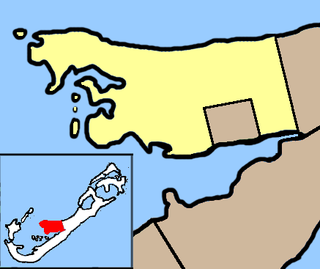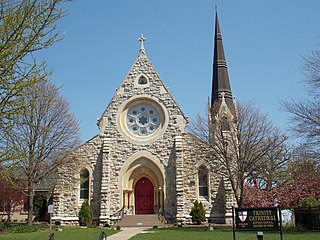
A parish church in Christianity is the church which acts as the religious centre of a parish. In many parts of the world, especially in rural areas, the parish church may play a significant role in community activities, often allowing its premises to be used for non-religious community events. The church building reflects this status, and there is considerable variety in the size and style of parish churches. Many villages in Europe have churches that date back to the Middle Ages, but all periods of architecture are represented.

The City of Hamilton, in Pembroke Parish, is the territorial capital of the British Overseas Territory of Bermuda. It is the territory's financial centre and a major port and tourist destination. Its population of 854 (2016) is one of the smallest of any capital city.

The Anglican Church of Canada is the province of the Anglican Communion in Canada. The official French-language name is l'Église anglicane du Canada. In 2017, the Anglican Church counted 359,030 members on parish rolls in 2,206 congregations, organized into 1,571 parishes. The 2011 Canadian census counted 1,631,845 self-identified Anglicans, making the Anglican Church the third-largest Canadian church after the Catholic Church and the United Church of Canada. The 2021 Canadian census counted more than 1 million self-identified Anglicans, remaining the third-largest Canadian church.

Sir Arthur William Blomfield was an English architect. He became president of the Architectural Association in 1861; a Fellow of the Royal Institute of British Architects in 1867 and vice-president of the RIBA in 1886. He was educated at Trinity College, Cambridge, where he studied Architecture.

The Cathedral of St. John the Baptist is located in the city of St. John's, Newfoundland and Labrador, Canada.

James Butler Knill Kelly was a bishop of the Church of England active in the British colony of Newfoundland and in Scotland. Kelly was a participant in the first Lambeth Conference, which was a crucial step in the creation of the Anglican Communion. He was also Primus of the Scottish Episcopal Church from 1901 to 1904.

Pembroke Parish is one of the nine parishes of Bermuda. It is named after English aristocrat William Herbert, 3rd Earl of Pembroke (1580–1630).

The Diocese of Nova Scotia and Prince Edward Island is a diocese of the Ecclesiastical Province of Canada of the Anglican Church of Canada. It encompasses the provinces of Nova Scotia and Prince Edward Island and has two cathedrals: All Saints' in Halifax and St. Peter's in Charlottetown. Its de facto see city is Halifax, and its roughly 24 400 Anglicans distributed in 239 congregations are served by approximately 153 clergy and 330 lay readers according to the last available data. According to the 2001 census, 120,315 Nova Scotians identified themselves as Anglicans, while 6525 Prince Edward Islanders did the same.

Holy Trinity Cathedral is an Anglican place of worship situated in Parnell, a residential suburb of Auckland, New Zealand. It is the 'mother church' of the Anglican Diocese of Auckland and the cathedral of the Bishop of Auckland. The current main church building was consecrated in 1973.

Trinity is a small town located on Trinity Bay in Newfoundland and Labrador. The town contains a number of buildings recognized as Registered Heritage Structures by the Heritage Foundation of Newfoundland and Labrador.

The Anglican Church of Bermuda is a single diocese consisting of nine parishes and is part of the Anglican Communion, though not a part of an ecclesiastical province. The current Bishop of Bermuda, seated at the Cathedral of the Most Holy Trinity in the City of Hamilton, is Nicholas Dill, who was installed on 29 May 2013.
Robert Lowder Seaborn was a Canadian minister of the Anglican faith. He was the Anglican Bishop of Newfoundland in Canada from 1965 to 1980.

Trinity Episcopal Cathedral, formerly known as Grace Cathedral, is the historic cathedral in the Diocese of Iowa. The cathedral is located on the bluff overlooking Downtown Davenport, Iowa, United States. Completed in 1873, Trinity is one of the oldest cathedrals in the Episcopal Church in the United States. It was individually listed on the National Register of Historic Places in 1974. In 1983 the cathedral was included as a contributing property in the College Square Historic District, which is also listed on the National Register.

The Anglican Diocese of Newfoundland was, from its creation in 1839 until 1879, the Diocese of Newfoundland and Bermuda, with the Cathedral of St. John the Baptist at St. John's, Newfoundland, and a chapel-of-ease named Trinity Church in the City of Hamilton in Pembroke Parish, Bermuda. Newfoundland and Bermuda had both been parts of British North America until left out of the 1867 Confederation of Canada. In 1842, her jurisdiction was described as "Newfoundland, the Bermudas". In 1879 the Church of England in the British Overseas Territory of Bermuda was created, but continued to be grouped with the Diocese of Newfoundland under the bishop of Newfoundland and Bermuda until 1919, when Newfoundland and Bermuda each received its own bishop.
William Hay was a Scottish architect who was actively working internationally from 1842 to 1887. A specialist in gothic architecture, he is primarily known for his work on several churches and cathedrals. His most famous structure is the Bermuda Cathedral in Hamilton, Bermuda which he designed in 1885. Construction of the cathedral began in 1886 and was completed seven years after Hay's death in 1905. He also designed some of the oldest buildings and structures in Toronto, Ontario, from 1853–1861, and was responsible for the restoration of St. Giles' Cathedral in Edinburgh from 1872–1884. His career exemplifies how the British Empire of the Victorian Era was united not only by military and political strength but also by professionals who took advantage of opportunities in its wide array of territories.
Donald Frederick Harvey is a Canadian Anglican bishop. He was the Moderator Bishop and director of the Anglican Network in Canada, a founding diocese of the Anglican Church in North America, from 2009 to 2014, and the Director of Anglican Essentials Canada. He was previously the Bishop of Eastern Newfoundland and Labrador in the Anglican Church of Canada from 1993 to 2004.
Geoffrey Curtis Ralph Peddle was the bishop of the Diocese of Eastern Newfoundland and Labrador from 2014 to 2020.

Sir Joseph Outerbridge was a prominent Bermudian businessman and philanthropist in Newfoundland.

St. John's Ecclesiastical District is a formally-recognized heritage precinct, located in the central part of St. John's, Newfoundland and Labrador. It is composed of separate nodes containing buildings and spaces associated with the Roman Catholic, Anglican, United Church of Canada, and Presbyterian denominations and is representative of the involvement of Christian institutions in the history and political life of St. John's and the province.
Rev. Mark James was a British Anglican cleric who served as Rector of Pembroke and Devonshire, Bermuda, Canon of Bermuda Cathedral and de jure head of the Anglican Church of Bermuda.





















